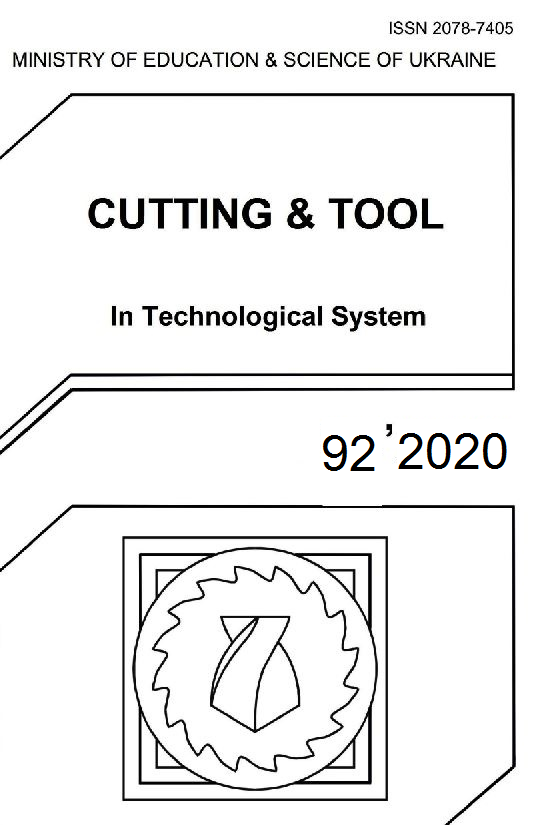WARNING WARNING OF PERFORMANCE GRINDING WHEELS OF EXTRACTIVE MATERIALS
DOI:
https://doi.org/10.20998/2078-7405.2020.92.17Keywords:
relative wear, working surface of the wheels, intermittent grinding, cutting protrusion.Abstract
When grinding circles, the working surface of which consists of periodically protrusions and depressions, in the elastic system of the machine due to the interruption of the cutting process there are high-frequency oscillations of small amplitude, which facilitate the process of chip formation and contribute to the formation of a developed cutting microrelief. However, at certain ratios of lengths of the cutting projections and depressions and at certain their quantities, parametric resonance may occur, which is a prerequisite for a periodic change in the stiffness time of the elastic system of the machine. Parametric resonance has a negative effect not only on the specific wear of the diamond kkol, but also on the quality of the machined surface. This implies the need for further exploration of the effect of parametric resonance arising from intermittent grinding on the relative flow of diamond circles. In the article, using the calculated and experimental ways, identified The extreme nature of the dependences of the specific wear of discontinuous circles of superhard materials on the number of slots on the working surface of the tool and on the ratio of the extent of the cavity to the length of the cutting ridge of the circle. Also, using the computational and experimental ways the characters of the influence of the dimensions and number of structural elements from which the working surface of diamond discontinuous circles was formed, as well as the rigidity of cutting on the parametric stability of the elastic system of a surface grinding machine, were revealed. The nature of the influence of the size and number of structural elements from which the working surface of diamond discontinuous wheels is formed, as well as the cutting rigidity on the parametric stability of the elastic system of the surface grinding machine is revealed by calculation and experiment.References
Lukin, L.L. Raschet preryivistyih krugov pri ploskom periferiynom shlifovanii /L.L. Lukin, V.D. Starshev // Vestnik Izh.GTU. – 2007. – #1, – pp. 38-39.
Gunko, N.I. Issledovanie vliyaniya zhestkosti ploskoshlifovalnogo stanka na iznos abrazivnyih krugov pri preryivistom shlifovanii /N.I. Gunko // Chistovyie metodyi obrabotki: sb. nauchn. trudov. – Perm: Permskiy politehnicheskiy institut, 1971. – Vyip. 97, – pp. 3-8.
Gutsalenko, Yu.G. Stiykist kruga v robochih protsesah ratsionalnogo stabilnogo shlifuvannya // Visn. nats. tehn. un-tu «KharkIvskiy polItehnIchniy Institut» – 2005. – #23. – pp. 50-63.
Almaznaya obrabotka: uchebn. posobie [dlya stud. vyissh. uch. zaved.] /A.V. Yakimov, F.V. Novikov, G.V. Novikov, A.A. Yakimov. – K.: ISMO, 1996. – 168 p.
Tehnologiya mashinostroeniya: Uchebnik. /A.V. Yakimov, F.V. Novikov, P.A. Linchevskiy,V.P. Larshin,E.V. Grisenko, A.A. Yakimov, A.V. Fadeev, G.V. Novikov. - Odessa: ONPU, 2012.- 693 p.
Yakimov, A.V. Vyisokoproizvoditelnaya obrabotka abrazivno-almaznyimi instrumentami: uchebn. posobie [dlya stud. vyissh. uchebn. zaved.] / A.V. Yakimov, F.V. Novikov, A.A. Yakimov. – Kyiv: Tehnika, 1993, – 152 p.
Radzevich, S.P. Dudleys Handbook of Practical Gear Design and Manufacture/ 2-nd Edition, SRS Press, Boca Raton, Flonda, 2011, 1111 pages.
Semko, M.F. Osnovyi almaznogo shlifovaniya/M.F. Semko, A.I. Grabchenko, A.F. Rab, M.D. Uzunyan, M.S. Pivovarov. – Kyiv: Tehnika, 1978, – 192 p.
Downloads
Published
Issue
Section
License
Copyright Notice
Authors who publish with this Collection agree to the following terms:
1. Authors retain copyright and grant the Collection right of first publication with the work simultaneously licensed under a Creative Commons Attribution License that allows others to share the work with an acknowledgement of the work's authorship and initial publication in this Collection.
2. Authors are able to enter into separate, additional contractual arrangements for the non-exclusive distribution of the Collection's published version of the work (e.g., post it to an institutional repository or publish it in a book), with an acknowledgement of its initial publication in this Collection.
3. Authors are permitted and encouraged to post their work online (e.g., in institutional repositories or on their website) prior to and during the submission process, as it can lead to productive exchanges, as well as earlier and greater citation of published work.

